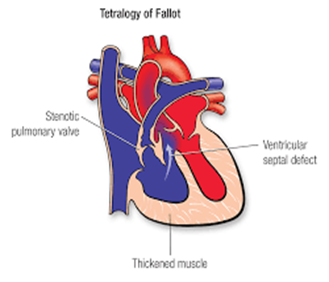The Foley Family is caring for their youngest child, Justin, who is suffering from tetralogy of Fallot. Which of the following are defects associated with this congenital heart condition?
Coarctation of aorta, aortic valve stenosis, mitral valve stenosis, and patent ductus arteriosus
Ventricular septal defect, overriding aorta, pulmonic stenosis (PS), and right ventricular hypertrophy
Aorta exits from the right ventricle, pulmonary artery exits from the left ventricle, and two noncommunicating circulations
Tricuspid valve atresia, atrial septal defect, ventricular septal defect, and hypoplastic right ventricle
The Correct Answer is B
Tetralogy of Fallot is a congenital heart defect characterized by four specific abnormalities:
Ventricular septal defect (VSD): This is a hole in the wall (septum) between the two lower chambers (ventricles) of the heart.
Overriding aorta: The aorta is positioned over both the left and right ventricles, which allows oxygen-poor (deoxygenated) blood from the right ventricle to be pumped into the aorta and to the body.
Pulmonic stenosis (PS): This is a narrowing of the pulmonary valve or artery that restricts blood flow from the right ventricle to the lungs.
Right ventricular hypertrophy: The right ventricle becomes thicker and more muscular as it works harder to pump blood against the narrowed pulmonary valve or artery.
Options A, C, and D describe different congenital heart conditions and defects, but they are not associated with Tetralogy of Fallot:
A. Coarctation of aorta, aortic valve stenosis, mitral valve stenosis, and patent ductus arteriosus are not part of the constellation of defects seen in the Tetralogy of Fallot.
C. Describing the aorta exiting from the right ventricle and pulmonary artery exiting from the left ventricle with two noncommunicating circulations is characteristic of transposition of the great arteries, not Tetralogy of Fallot.
D. Tricuspid valve atresia, atrial septal defect, ventricular septal defect, and hypoplastic right ventricle describe a different congenital heart condition, not Tetralogy of Fallot.

Nursing Test Bank
Naxlex Comprehensive Predictor Exams
Related Questions
Correct Answer is A
Explanation
B. Cardiac Catheterization.
Cardiac Catheterization (B): Cardiac catheterization is an invasive procedure that involves threading a catheter into the heart's chambers and major blood vessels. It allows direct visualization of the coronary arteries, measurement of blood pressure within the heart, assessment of blood flow, and the ability to perform interventions such as angioplasty or stent placement. Cardiac catheterization is considered the gold standard for diagnosing coronary artery disease, evaluating heart valve function, and detecting congenital heart abnormalities.
Explanation:
A. Echocardiogram (A): An echocardiogram is a non-invasive imaging test that uses sound waves to create images of the heart. It is excellent for assessing the structure and function of the heart, including heart valve function and blood flow patterns. While it is a valuable tool for cardiac assessment, it may not provide the level of detail and direct visualization that cardiac catheterization offers.
C. Chest X-Ray (CXR) (C): A chest X-ray can provide information about the size and shape of the heart and detect certain abnormalities such as an enlarged heart or fluid in the lungs. However, it may not offer the level of detail required to diagnose specific cardiac issues accurately.
D. Electrocardiogram (ECG) (D): An ECG records the electrical activity of the heart and is useful for diagnosing arrhythmias and certain conduction abnormalities. While it provides essential information about cardiac rhythm, it does not directly visualize the structural aspects of the heart or blood flow.
In summary, while each of these diagnostic tools plays a crucial role in assessing cardiac issues, cardiac catheterization is the most accurate and comprehensive option for diagnosing a wide range of cardiac conditions due to its direct visualization and intervention capabilities. However, the choice of diagnostic test should always be made based on the patient's specific clinical presentation and the suspected cardiac problem.
Correct Answer is A
Explanation
Cardioversion involves delivering an electrical shock to the heart to restore a normal rhythm. While it may be used for certain types of tachyarrhythmias in adults, it is typically not the first-line treatment for SVT in pediatric patients.
In pediatric patients with SVT, the initial management options often include:
B. Vagal maneuvers: Non-invasive maneuvers like the Valsalva maneuver or carotid sinus massage can be attempted to try and break the SVT rhythm.
C. Adenosine: Adenosine is often the first-line medication used for terminating SVT in pediatric patients. It is given intravenously in a controlled setting under medical supervision.
D. Continue to monitor for 30 minutes: After successful termination of SVT, it's important to continue monitoring the child's heart rhythm and vital signs to ensure that the arrhythmia does not recur.
In pediatric patients, the decision to use cardioversion is usually reserved for situations where other methods, including medications and vagal maneuvers, have not been successful or if the child is unstable. Cardioversion in pediatric patients is performed under sedation or anesthesia to minimize discomfort.
Therefore, while cardioversion may be used in some cases, it is not the initial or most common approach for treating SVT in pediatric patients, making option A the answer to the question.
Whether you are a student looking to ace your exams or a practicing nurse seeking to enhance your expertise , our nursing education contents will empower you with the confidence and competence to make a difference in the lives of patients and become a respected leader in the healthcare field.
Visit Naxlex, invest in your future and unlock endless possibilities with our unparalleled nursing education contents today
Report Wrong Answer on the Current Question
Do you disagree with the answer? If yes, what is your expected answer? Explain.
Kindly be descriptive with the issue you are facing.
